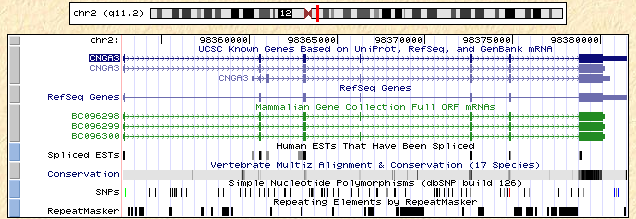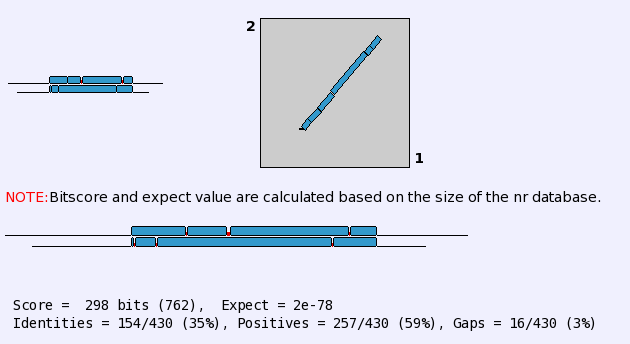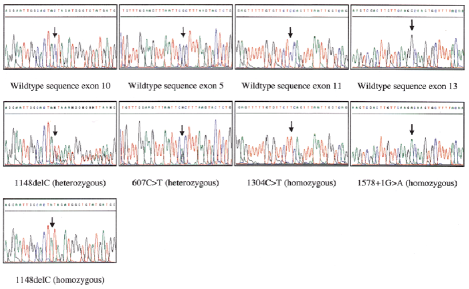This web page was produced as an assignment for an undergraduate course at Davidson College.
The Genetic Basis for Achromatopsia
Different Reporting Styles in the Media
About Achromatopsia
Color blindness is generally defined as the inability to differentiate between hues of color. The most common forms of color blindness are red-green (sometimes referred to as Daltonian) and blue-purple. There is also a form of color blindness in which all ability to distinguish hues is lost, called achromatopsia. People with this condition are generally considered to be legally blind, but a significant portion of people with red-green or blue-purple color blindness are unaware of their condition. Daltonian color-blindness is an X-linked trait, with the vast majority of those affected being male. Achromatopsia can be caused either by genetic defect or through cerebral damage, and affects men and women with equal frequencies.
An island in Micronesia has a very high frequency of achromatopsia. It is thought that due to a severe storm a few hundred years ago, much of the genetic diversity on the island was erased. A few individuals remaining carried genetic mutations that cause achromatopsia. This island has become the center of attention for much research into achromatopsia.
Scientific journals and the popular press often report on scientific discoveries in markedly different ways. What follows is a comparison of these differing treatments. This web page focuses on achromatopsia, or "true" color blindness, and compares and contrasts the ways in which the various scientific journals and venues of popular press discuss the disease.
Scientific Journals
A group of researchers from the United States, Germany, Italy, and the Federated States of Micronesia published an original research paper in 2000 on their discovery of a different genetic mutation responsible for achromatopsia. Previous to this discovery, another gene, CNGA3 on chromosome 2q11, had been found to cause achromatopsia (Kohl et. al, 2000). It had been known that there was another locus which also contained a genetic mutation responsible for achromatopsia, on chromsome 8q21. The researchers found the gene using contigs stitched together with yeast artifical chromosomes. The scientists then "identified two overlapping high throughput genomic sequencing phase (HTGS) entries which contained sequences homologous to the murine cng6 gene encoding the putative Β-subunit of the cone photoreceptor cGMP-gated channel" (Kohl et. al, 2000). They found a cDNA gene, called it CNGB3, and detected it in the retina. They then found six different mutations in this gene, all resulting in achromatopsia.
The research paper provides copious amounts of data, showing the family inheritance patterns, the physical mapping of the genes in the ACHM3 region, and sequencing results. As a scientific publication, it assumes that its readership is fluent in state of the art biological methodology and a solid understanding of genetics. Little background information is given on the history of the disease.
Figure 1: Mutations that cause achromatopsia. (click for a larger version)
Source: Susanne Kohl, Britta Baumann, Martina Broghammer, Herbert Jägle, Paul Sieving, Ulrich Kellner, Robert Spegal, Mario Anastasi, Eberhart Zrenner, Lindsay T. Sharpe, and Bernd Wissinger. Mutations in the CNGB3 gene encoding the Β-subunit of the cone photoreceptor cGMP-gated channel are responsible for achromatopsia (ACHM3) linked to chromosome 8q21. Human Molecular Genetics. Oxford UP: Vol 9, No. 14. 2000. pp2107-2116.
Two of the researchers from the group which discovered CNGB3, Bernd Wissinger and Lindsay T. Sharpe, went on to publish a paper with a broader focus on color blindness. This paper covers the basics of vision, the evolution of cone-pigment genes in humans, structural variabilities between green and red vision proteins, and some of the different types of color blindness. This paper was quite useful in helping me understand some of the more basic ways in which eyes function. It requires basic understanding of biology and physiology and some genetics.
Source: Bernd Wissinger and Lindsay T. Sharpe. New Aspects of an Old Theme: The Genetic Basis of Human Color Vision. American Journal of Human Genetics. 63:1257-1262, 1998.
The Popular Press
An article written for Science News reports on the gene mutation responsible for achromatopsia.
Source: Seppa, Nathan. "Gene Mutation for Color Blindness Found." Science News. Vol. 158, Issue 4, p63. 07/22/2000.
http://www.sciencenews.org/articles/20000722/note20ref.asp
The article is targeted at people who are somewhat science literate. The first paragraph does a good job summarizing the history, relevance, and interest of the gene. The paragraph glosses over the ideas behind inheritance and the disease phenotype, which is useful for those who are not fluent in Mendelian genetics.
The article's subsequent paragraph introduces the new discovery for the origin of the disease. It does name the gene, CNGB3, and discusses briefly the methods used to find the mutation by analyzing the island populace. It then goes on to talk about the amino acid substitution of phenylalanine for serine, and how this is the cause of the blindness.
What the article does not explain well is how an amino acid substitution is harmful. Due to the ubiquity of phenylalaines, thre must be lots of phenylalanines elsewhere in eye proteins; yet these do not cause any harm. To someone who does not know what an amino acid is, he or she may assume that all phenylalanines are inherently detrimental to eyesight. Additionally, according to the original research paper, there were actually more than one mutation found in the gene. This article ignores that fact, and generalizes the cause to a single amino acid substitution.
The finishing paragraph talks a little more about Mendelian genetics and how the gene is recessive, useful to understand the genetics at a basic level, but not very informative to most biologists since it is not uncommon for genes to follow this inheritance pattern. The article is short, and manages to fit in a mixture of background information, basic biology, and touches on one of the causes of blindness.
Databases Online
Through the use of online databases, such as the Online Mendelian Inheritance in Man, or the Human Genome Browser, it is possible to easily visualize the locations of genes on the human chromosome.
Figure 2: Human Genome Browser View of CNGB3

Figure 3: OMIM View of CNGB3

Figure 4: Human Genome Browser View of CNGA3

Figure 5: OMIM View of CNGA3

By looking at these figures, we see that there are only a few coding regions within the gene, and a simple comparison between the two genes shows some similarity. However, for some reason CNGB3 shows much more conservation, more SNPs, and more repeats in the repeat masker.
Figure 6: Out of curiosity, I decided to compare the two genes that cause achromatopsia, CNGA3 and CNGB3. By using NCBI's Blast2 protein alignment tool, I found that the two genes are indeed similar. We see that 35% of the amino acids in the two proteins are identical, 59% are positives, with the remaining 3 percentage points in a few small gaps. Positives are determined by the similarities of different amino acids as defined by the Blosum62 matrix. Thus nearly two thirds of the proteins are comprised of different amino acids but retain structural similarities. The overall score is 2e-78, which indicates "the number of alignments that you expect to find by chance (i.e. with no evolutionary relationship) with bit scores at least as large as the bit score of this hit" (Campbell and Heyer, 2006). 2e-78 is thus a good indication of evolutionary relationship. The bitscore of 298 reflects that there were a large number of matching amino acids, and thus that the two protein sequences are similar.

Links On the Web
Wikipedia: http://en.wikipedia.org/wiki/Achromatopsia
Wikipedia (French): http://fr.wikipedia.org/wiki/Achromatopsie
The Achromatopsia Network: http://www.achromat.org/
The Achromatopsia Group: http://www.achromatopsia.org/
The American Association for Pediatric Opthamology and Strabismus - Achromatopsia: http://www.aapos.org/displaycommon.cfm?an=1&subarticlenbr=60
Gene Card Information about CNGB3: http://www.genecards.org/cgi-bin/carddisp.pl?gene=CNGB3
References
A. Malcom Campbell and Laurie J. Heyer. Discovering Genomics, Proteomics, & Bioinformatics, Second Edition. Cold Spring Harbor and Benjamin Cummings: 2006.
Susanne Kohl, Britta Baumann, Martina Broghammer, Herbert Jägle, Paul Sieving, Ulrich Kellner, Robert Spegal, Mario Anastasi, Eberhart Zrenner, Lindsay T. Sharpe, and Bernd Wissinger. Mutations in the CNGB3 gene encoding the Β-subunit of the cone photoreceptor cGMP-gated channel are responsible for achromatopsia (ACHM3) linked to chromosome 8q21. Human Molecular Genetics. Oxford UP: Vol 9, No. 14. 2000. pp2107-2116.
Seppa, Nathan. "Gene Mutation for Color Blindness Found." Science News. Vol. 158, Issue 4, p63. 07/22/2000.
Bernd Wissinger and Lindsay T. Sharpe. New Aspects of an Old Theme: The Genetic Basis of Human Color Vision. American Journal of Human Genetics. 63:1257-1262, 1998.
